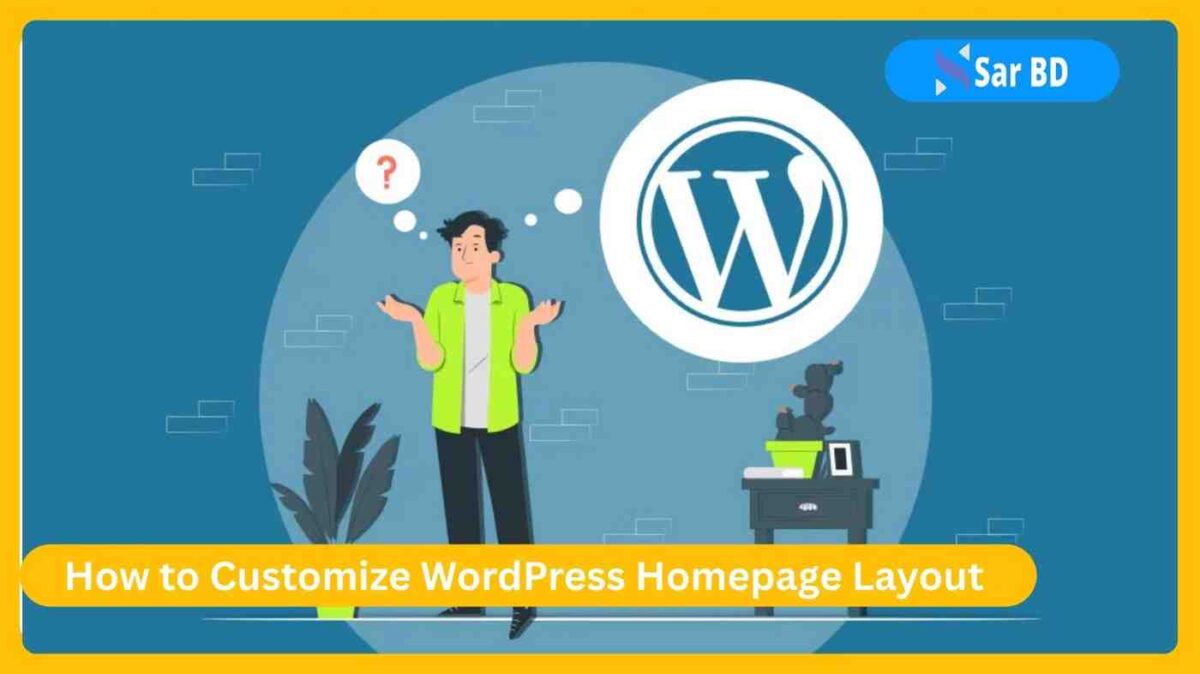How to Customize WordPress Homepage Layout: A Complete Guide for 2025
Your website’s homepage is the digital front door to your brand. Whether you’re running a blog, e-commerce store, portfolio, or business site, your homepage determines the first impression users have about you. That’s why learning how to customize WordPress homepage layout is crucial for building trust, increasing engagement, and boosting conversions. In this guide, we’ll walk you through everything you need to know to professionally customize WordPress homepage layout in a step-by-step and SEO-friendly way.
Why Customize WordPress Homepage Layout?
Before diving into the steps, let’s understand the importance of homepage customization:
- First Impressions Matter: Visitors often judge the quality of your entire site by its homepage. A well-designed layout grabs attention instantly.
- Better Branding: Customizing your homepage lets you showcase your logo, tagline, colors, and typography in a cohesive way.
- Enhanced Navigation: A personalized homepage layout allows you to highlight key sections like services, blog, contact, or testimonials.
- SEO Benefits: Customizing layout with strategic headings, keyword placement, and multimedia enhances your homepage’s visibility.
- User Engagement: With CTAs, animations, and interactive sections, users are more likely to scroll, click, and engage.
- Conversion Optimization: Whether it’s collecting emails or driving sales, a custom layout helps guide visitors toward your goals.
- Mobile Responsiveness: A customized layout can be optimized for devices of all sizes.
- Competitive Edge: Standing out from cookie-cutter templates sets your site apart in a crowded digital space.
Getting Started: Choose How You Want to Customize WordPress Homepage Layout
There are several approaches you can take when you want to customize WordPress homepage layout. Below are the most effective methods for 2025.
1. Using WordPress Theme Customizer
If you’re using a WordPress theme that supports live customization, the built-in WordPress Customizer is your starting point.
- Access the Customizer: From your WordPress dashboard, navigate to Appearance > Customize. This opens a live preview window with configuration options on the left.
- Set a Static Homepage: Go to Homepage Settings and select “A static page.” Then choose a specific page as your homepage. This is essential if you don’t want your blog posts to be the default view.
- Edit Site Identity: Customize your logo, site title, and tagline. These are the first things visitors see and are critical for branding.
- Layout Controls: Many themes offer layout settings for columns, sidebar positions, header styles, and footer visibility.
- Customize Colors & Fonts: Choose your site’s color scheme and typography directly in the Customizer. This keeps your branding consistent.
- Enable/Disable Widgets: You can control what widgets show up on the homepage from this panel. Remove anything irrelevant and add useful ones like featured posts or social media icons.
- Add Menus & Navigation: Modify your primary navigation to guide users to other important sections of your site.
- Live Preview: Every change is shown in real-time, so you can experiment freely before publishing.
2. Customize WordPress Homepage Layout Using Page Builders (Elementor, WPBakery, etc.)
Page builders offer drag-and-drop ease, allowing you to fully customize WordPress homepage layout without touching code.
- Install Your Preferred Page Builder: Elementor (free or Pro), WPBakery, Beaver Builder, or Thrive Architect are great options. Install and activate via the Plugins section.
- Create a New Homepage Page: Go to Pages > Add New and name it “Home.” Edit with your selected builder to start from scratch.
- Use Pre-designed Templates: Most builders come with pre-made homepage layouts. Choose one that suits your niche and customize the content.
- Drag & Drop Widgets: Add images, text, buttons, sliders, testimonials, and video blocks. Every element is customizable.
- Responsive Editing: Switch between desktop, tablet, and mobile views to ensure your layout is responsive across all devices.
- Add Animations and Effects: Make your homepage more interactive with fade-ins, slide-ins, and hover effects.
- Insert Call to Actions (CTAs): Strategically place buttons like “Shop Now,” “Subscribe,” or “Contact Us” to drive conversions.
- Save and Publish: Once you’re satisfied, publish the page and set it as the static homepage from Settings > Reading.
3. Customize WordPress Homepage Layout via Block Editor (Gutenberg)
Gutenberg, the default block editor in WordPress, has become more powerful and now supports full-page customization.
- Create or Edit a Homepage: Navigate to Pages > Add New (or edit an existing one). Make sure this page is assigned as your homepage.
- Use Layout Blocks: Use Group, Columns, Cover, and Spacer blocks to structure your homepage layout. This helps you define sections and layouts.
- Insert Dynamic Content: Add blog posts, featured images, latest comments, or other dynamic content using query loops and post lists.
- Utilize Reusable Blocks: If you plan to reuse sections like newsletter sign-ups or testimonials across pages, save them as reusable blocks.
- Theme Compatibility: Modern WordPress themes (like Astra, Kadence, or Neve) work great with Gutenberg, allowing deeper layout control.
- Use Full-Site Editing (FSE): If your theme supports FSE, use the Site Editor to modify headers, footers, and template parts.
- Preview and Optimize: Always preview before publishing and check responsiveness.
- Minimal Plugins Required: Gutenberg uses core functionality, which keeps your site fast and lean.
4. Using Custom Widgets to Customize WordPress Homepage Layout
Widgets offer a flexible way to enhance the layout, especially in widget-ready themes.
- Navigate to Widgets Area: Go to Appearance > Widgets. You’ll see widget areas defined by your theme.
- Add Custom Text or HTML: Use a Text or Custom HTML widget to add banners, embedded videos, or announcements.
- Add Categories or Post Widgets: Showcase your blog categories or recent posts. You can also filter by tags or popularity.
- Insert Social Media Feeds: Use plugins or embed codes to show Facebook, Instagram, or Twitter feeds.
- Use Image Widgets: Add clickable image banners to promote products or blog posts.
- Newsletter Signup Forms: Integrate services like Mailchimp or ConvertKit using their widget codes.
- Promotions and Events: Display special deals, countdown timers, or upcoming events using dedicated widgets.
- Customize with CSS: Tweak the look and feel of each widget using additional CSS settings.
5. Customize WordPress Homepage Layout with Theme Builder Tools
Theme builder tools allow you to override default theme layouts completely.
- Use Elementor Pro or Thrive Theme Builder: These tools give you full control over your site’s structure, not just content.
- Create Custom Templates: Build a homepage template from scratch with headers, footers, and dynamic sections.
- Assign Display Rules: Choose where and when your custom homepage appears. For example, you might want different layouts for mobile users.
- Import Demo Layouts: Use demo imports to start quickly, then adjust the layout, images, and text to suit your brand.
- Customize Theme Parts: Modify theme areas like hero sections, grids, testimonial carousels, and more.
- Integrate with WooCommerce: Build a homepage layout that features products, categories, and promotions if you’re running a store.
- Use Theme Style Guides: Set global fonts, colors, spacing, and button styles to ensure consistency.
- Auto-Save and Revisions: Work confidently knowing your changes are autosaved and you can revert at any time.
Key Elements to Include When You Customize WordPress Homepage Layout
To make your homepage layout truly effective, include these critical components:
- Hero Section: Your hero area is the first thing users see. Include a striking image or video background, headline, and a strong CTA.
- About or Intro Section: Briefly tell visitors who you are and what you offer. Keep it compelling and authentic.
- Services or Product Highlights: Use cards, icons, or columns to showcase your core offerings clearly and attractively.
- Testimonials or Reviews: Display quotes or star ratings from satisfied clients to build social proof.
- Contact Section: Add a contact form, phone number, or clickable WhatsApp chat to drive conversions.
- Newsletter Subscription: Capture leads by adding a simple sign-up form connected to your email service.
- Latest Blog Posts or News: Keep your homepage dynamic by displaying recent blog posts or updates.
- Trust Badges or Partners: Logos of your partners or awards can help enhance your brand credibility.
FAQs About How to Customize WordPress Homepage Layout
Q1. Can I customize WordPress homepage layout without a plugin?
Yes, you can use the Gutenberg block editor and WordPress Customizer without any additional plugins.
Q2. Is Elementor free enough to customize WordPress homepage layout?
Yes, the free version offers basic drag-and-drop layout building. For advanced features like global styles or custom headers, Elementor Pro is recommended.
Q3. Will customizing the homepage affect site speed?
If optimized well and not overloaded with animations or heavy media, customization won’t negatively impact performance.
Q4. Can I create different homepage layouts for mobile and desktop?
Yes. Most page builders let you design separately for desktop, tablet, and mobile views.
Q5. Is it possible to have a video background in the homepage layout?
Absolutely. Both Gutenberg and page builders support video backgrounds in hero sections.
Q6. Can I change homepage layout later without losing content?
Yes, but always back up your site before making major layout changes.
Q7. Are there free themes that allow homepage customization?
Yes. Astra, OceanWP, and Neve are some free themes that offer extensive homepage layout options.
Q8. Is it SEO-safe to customize WordPress homepage layout?
Yes. In fact, a well-customized layout helps improve SEO by optimizing content structure, keyword placement, and user experience.
Final Thoughts: Take Control of Your WordPress Homepage Today
Learning how to customize WordPress homepage layout is one of the most impactful ways to improve your website’s performance. A strategically designed homepage creates stronger branding, better engagement, and ultimately higher conversions. Whether you’re using the Customizer, Gutenberg, or advanced page builders, the tools available today make it easier than ever to create a homepage that truly represents your vision.
Now that you understand how to customize WordPress homepage layout professionally, it’s time to take action. Pick your preferred method and start experimenting with layouts today. And if you found this guide helpful, feel free to share it with others or drop your questions in the comments below. Your ideal homepage is just a few clicks away!


